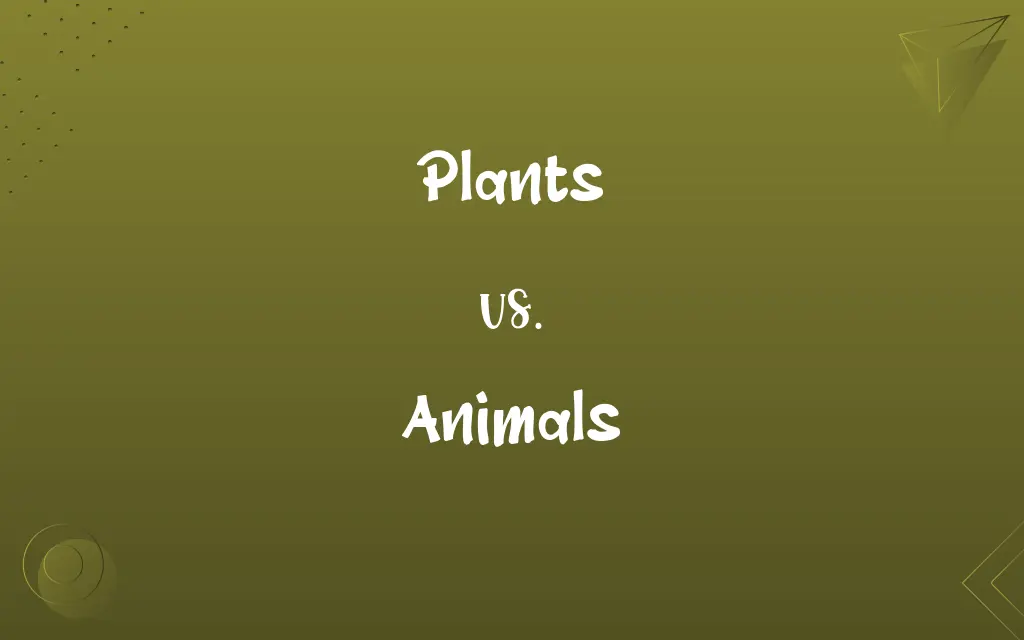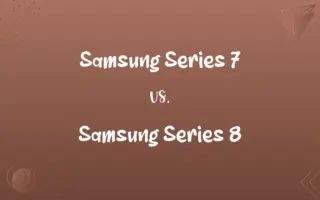Plants vs. Animals: Know the Difference

By Shumaila Saeed || Published on February 9, 2024
Plants are living organisms that primarily photosynthesize and have cell walls made of cellulose, whereas animals are multicellular organisms that consume organic material and lack cell walls.

Key Differences
Plants are primarily autotrophic, meaning they produce their own food through photosynthesis using sunlight, water, and carbon dioxide. This fundamental process occurs in chloroplasts within their cells. Animals, in contrast, are heterotrophic and depend on consuming organic material for energy. They lack the ability to photosynthesize and must obtain food by eating plants, other animals, or organic substances.
Shumaila Saeed
Feb 09, 2024
The cellular structure of plants includes rigid cell walls made of cellulose, providing structural support and shape. This cell wall is absent in animals, whose cells are surrounded only by a thin, flexible plasma membrane. The presence of a cell wall in plants contributes to their generally stationary nature, as opposed to the mobility observed in most animals.
Shumaila Saeed
Feb 09, 2024
In terms of reproduction, many plants can reproduce both sexually (with flowers and seeds) and asexually (via methods like budding or cuttings). Animals predominantly reproduce sexually, although some can reproduce asexually through processes like budding, fragmentation, or parthenogenesis.
Shumaila Saeed
Feb 09, 2024
Plants typically do not have a nervous system or sensory organs, which are common in animals. This difference underlies the plants' lack of mobility and the animals' ability to move and respond rapidly to stimuli. Animals have developed various senses like sight, hearing, and touch, which are essential for survival and interaction with their environment.
Shumaila Saeed
Feb 09, 2024
Finally, in terms of growth, plants generally continue to grow throughout their lifespan due to meristematic tissues. Animal growth, however, is usually determinate, stopping when they reach a certain size and maturity. This continuous growth allows plants to adapt and expand in their environment, while animals' growth limitations are tied to their developmental stages.
Shumaila Saeed
Feb 09, 2024
ADVERTISEMENT
Comparison Chart
Food Production
Produce own food via photosynthesis
Consume organic material for energy
Shumaila Saeed
Feb 09, 2024
Cellular Structure
Have cell walls made of cellulose
Lack cell walls, only have plasma membrane
Shumaila Saeed
Feb 09, 2024
Reproduction
Capable of both sexual and asexual reproduction
Primarily sexual reproduction, some asexual
Shumaila Saeed
Feb 09, 2024
Sensory and Nervous System
Generally lack a nervous system and sensory organs
Possess a nervous system and sensory organs
Shumaila Saeed
Feb 09, 2024
Growth
Continuous growth throughout life
Determinate growth, stops at maturity
Shumaila Saeed
Feb 09, 2024
ADVERTISEMENT
Mobility
Typically stationary
Capable of movement and rapid response to stimuli
Shumaila Saeed
Feb 09, 2024
Plants and Animals Definitions
Plants
Plants reproduce through seeds, spores, or vegetative methods.
Many plants can reproduce through cuttings.
Shumaila Saeed
Jan 11, 2024
Animals
Animals are multicellular organisms that feed on organic matter.
Animals in the forest include deer, rabbits, and birds.
Shumaila Saeed
Jan 11, 2024
Plants
Plants are multicellular organisms with a complex cell structure including a cell wall.
Gardeners must understand plants' needs for proper care.
Shumaila Saeed
Jan 11, 2024
Animals
Animals reproduce mostly sexually, with diverse reproductive strategies.
Many animals have intricate mating rituals.
Shumaila Saeed
Jan 11, 2024
ADVERTISEMENT
Plants
Plants form the primary producers in most ecological systems.
Plants convert sunlight into energy, supporting entire ecosystems.
Shumaila Saeed
Jan 11, 2024
Animals
Animals possess specialized sensory and nervous systems.
Animals use their senses to navigate and find food.
Shumaila Saeed
Jan 11, 2024
Plants
Plants are predominantly stationary, growing in soil or water.
The plants in the garden grow upwards, seeking sunlight.
Shumaila Saeed
Jan 11, 2024
Animals
Any of numerous multicellular eukaryotic organisms of the kingdom Metazoa (or Animalia) that ingest food rather than manufacturing it themselves and are usually able to move about during at least part of their life cycle. Sponges, jellyfishes, flatworms, mollusks, arthropods, and vertebrates are animals.
Shumaila Saeed
Jan 11, 2024
Plants
Any of various photosynthetic, eukaryotic, multicellular organisms of the kingdom Plantae characteristically containing chloroplasts, having cell walls made of cellulose, producing embryos, and lacking the power of locomotion. Plants include trees, bushes, herbs, ferns, mosses, and certain green algae.
Shumaila Saeed
Jan 11, 2024
Plants
Any of various fungi, algae, or protists that resemble plants and were formerly classified in the plant kingdom. Not in scientific use.
Shumaila Saeed
Jan 11, 2024
Animals
A human considered with respect to their physical nature, as opposed to rational or spiritual nature.
Shumaila Saeed
Jan 11, 2024
Plants
A building or group of buildings for the manufacture of a product; a factory
Works in an auto plant.
Shumaila Saeed
Jan 11, 2024
Animals
A person having a specified aptitude or set of interests
“that rarest of musical animals, an instrumentalist who is as comfortable on a podium with a stick as he is playing his instrument” (Lon Tuck).
Shumaila Saeed
Jan 11, 2024
Plants
The buildings, fixtures, and equipment, including machinery, tools, and instruments, necessary for an industrial operation or an institution
The university's mechanical plant.
Shumaila Saeed
Jan 11, 2024
Animals
Relating to, characteristic of, or derived from an animal or animals, especially when not human
Animal cells.
Animal welfare.
Shumaila Saeed
Jan 11, 2024
Animals
Relating to the physical as distinct from the rational or spiritual nature of people
Animal instincts and desires.
Shumaila Saeed
Jan 11, 2024
Animals
Animals are capable of voluntary movement.
Animals in the wild constantly move in search of food and shelter.
Shumaila Saeed
Jan 11, 2024
Plants
A remark or action in a play or narrative that becomes important later.
Shumaila Saeed
Jan 11, 2024
Animals
Animals play various roles in ecosystems as consumers.
Predatory animals help maintain ecological balance.
Shumaila Saeed
Jan 11, 2024
Plants
To place (spawn or young fish) in water or an underwater bed for cultivation
Plant oysters.
Shumaila Saeed
Jan 11, 2024
Plants
To place or fix in a certain position
Planted both feet on the ground.
Planted a kiss on my cheek.
Shumaila Saeed
Jan 11, 2024
Plants
To fix firmly in the mind; implant
"The right of revolution is planted in the heart of man" (Clarence Darrow).
Shumaila Saeed
Jan 11, 2024
Plants
To station (a person) for the purpose of functioning in secret, as by observing, spying, or influencing behavior
Detectives were planted all over the store.
Shumaila Saeed
Jan 11, 2024
Plants
To place secretly or deceptively so as to be discovered or made public
Planted a gun on the corpse to make the death look like suicide.
Shumaila Saeed
Jan 11, 2024
Plants
Plants are living organisms capable of photosynthesis, typically characterized by green color.
The forest was lush with various green plants.
Shumaila Saeed
Jan 11, 2024
Repeatedly Asked Queries
Can plants grow indefinitely?
Many plants can grow continuously throughout their lives.
Shumaila Saeed
Feb 09, 2024
How do plants reproduce?
Plants can reproduce sexually through seeds or asexually through methods like cuttings.
Shumaila Saeed
Feb 09, 2024
Do plants have a nervous system?
Plants lack a traditional nervous system found in animals.
Shumaila Saeed
Feb 09, 2024
What is the primary role of plants in the ecosystem?
Plants are primary producers, creating energy through photosynthesis for other organisms.
Shumaila Saeed
Feb 09, 2024
How do animals reproduce?
Most animals reproduce sexually, though some can reproduce asexually.
Shumaila Saeed
Feb 09, 2024
Do all animals have a nervous system?
Most animals have a nervous system for sensing and responding to their environment.
Shumaila Saeed
Feb 09, 2024
Can plants sense their environment?
Plants can respond to environmental stimuli but do not sense like animals.
Shumaila Saeed
Feb 09, 2024
What are plants?
Plants are living organisms that produce their own food through photosynthesis.
Shumaila Saeed
Feb 09, 2024
What are animals?
Animals are multicellular organisms that consume organic matter for energy.
Shumaila Saeed
Feb 09, 2024
What differentiates plant cells from animal cells?
Plant cells have a rigid cell wall made of cellulose, unlike animal cells.
Shumaila Saeed
Feb 09, 2024
Do all plants need sunlight?
Most plants require sunlight for photosynthesis, but some can grow in low light.
Shumaila Saeed
Feb 09, 2024
Are there plants that can move?
Some plants exhibit limited movement, like the Venus flytrap.
Shumaila Saeed
Feb 09, 2024
How do plants affect climate change?
Plants absorb CO2, a greenhouse gas, helping mitigate climate change.
Shumaila Saeed
Feb 09, 2024
What roles do animals play in the ecosystem?
Animals serve as consumers, pollinators, predators, and play other ecological roles.
Shumaila Saeed
Feb 09, 2024
Can animals produce their own food?
No, animals cannot photosynthesize and must consume organic material.
Shumaila Saeed
Feb 09, 2024
Why are plants important for the environment?
Plants produce oxygen and remove carbon dioxide, supporting life on Earth.
Shumaila Saeed
Feb 09, 2024
Why is biodiversity important in plants and animals?
Biodiversity ensures ecosystem resilience and provides resources for all life forms.
Shumaila Saeed
Feb 09, 2024
Do animals play a role in plant reproduction?
Yes, many animals help in pollination and seed dispersal for plants.
Shumaila Saeed
Feb 09, 2024
How do animals adapt to their environment?
Animals adapt through various means like migration, hibernation, and physical changes.
Shumaila Saeed
Feb 09, 2024
What is the significance of animal migration?
Migration allows animals to find food, reproduce, and survive seasonal changes.
Shumaila Saeed
Feb 09, 2024
Share this page
Link for your blog / website
HTML
Link to share via messenger
About Author
Written by
Shumaila SaeedShumaila Saeed, an expert content creator with 6 years of experience, specializes in distilling complex topics into easily digestible comparisons, shining a light on the nuances that both inform and educate readers with clarity and accuracy.








































































